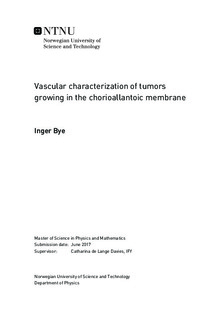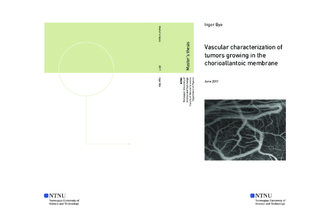| dc.description.abstract | The chick chorioallantoic membrane (CAM) model has been widely used to study different biological and medical processes, including angiogenic response, tumor development and drug-delivery. Such studies can be achieved because of the naturally immunodeficient system the chicken embryos possess the first couple of weeks of its development. The CAM of a developing chicken embryo provides an in vivo model, easily accessible for vascular and tumor imaging. In this master's thesis, the chorioallantoic membrane model was used to estimate the tumor vascular characteristics of human prostatic adenocarcinoma and human osteosarcoma. The same estimates were conducted on normal vasculature, and used as a control for comparison. Tumor vasculature is characterized by heterogeneous, abnormal blood vessels, both in structure and function. These irregularities give rise to enhanced vascular permeability, which is an important factor to consider in the delivery of therapeutic agents to tumors. The characteristics of tumor vasculature also lead to an increase in interstitial fluid pressure, which can result in a physiological barrier to the delivery of therapeutic agents
The experiments were performed by first inoculating cancer cells on the CAM's surface at day 6 of the embryo development. At day 13 or 14, fluorescent dextrans were injected into the blood vessel network, and visualized with an epi-fluorescent, widefield microscope. The characterizations involved estimates of different parameters, related to blood vessel permeability and the microvascular architecture. This included vascular extravasation rate of two sizes of dextrans (3-5 kDa and 40 kDa), vascular fraction, vascular number of branching points and vascular fractal dimension of both outlined and skeletonized branching patterns.
The dextran extravasation rate, from the vessels and into the extravascular extracellular space, was estimated by measuring the development of fluorescent intensities in both compartments over time. The 40 kDa dextran showed no significant difference between the vascular extravasation in the two cancer types. Neither were there any significant differences between extravasation in the two cancer types, when compared to the control vasculature. The smaller 3-5 kDa dextran, showed a high extravasation rate in the control vasculature, significantly higher than the prostatic tumor vasculature.
Vascular fractions, number of branching points and fractal dimensions, were estimated and used as characterizations of the microvascular architecture. The osteosarcoma vasculature showed significantly higher values in all these parameters compared to the control vasculature. The prostatic vasculature had only a significant higher number of branching points and fractal dimension (based on skeletonized branching pattern), compared to the control.
The extravasation rate of 40 kDa dextran was further related to the microvascular structure, and a significant correlation was found between the extravasation rate and fractal dimension (based on outlined branching patterns). With the estimates on microvascular structure, a significant correlation was found between the number of vascular branching points and fractal dimension (based on skeletonized branching patterns).
In conclusion, the CAM did not yet prove to be a precise model to study differences in vascular permeability by estimating the vascular extravasation rate. However, the model showed more promising results on the characterization of microvascular architecture, by detecting significant differences between tumor growth and normal tissue. | |

